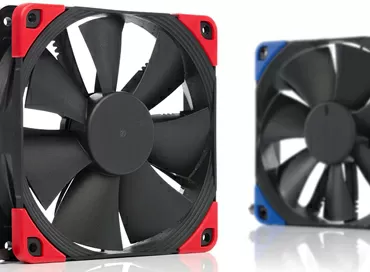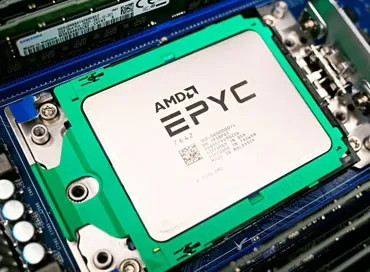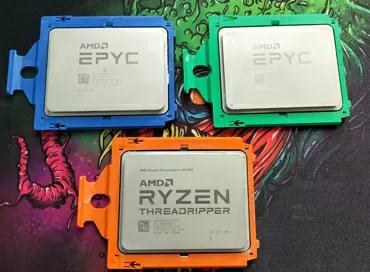Comparison of three Noctua coolers for workstations based on AMD EPYC 7000
AMD EPYC processors have a multicrystal layout (so-called chiplets), which makes the CPU bulky in terms of size, and, apparently, the tendency to increase their CPU size will continue in the future. Since the crystals in such a processor are not located in the middle, and indeed they can be located differently from series to series, the processor cooler will no longer be able to design in such a way as to place heat-conducting pipes above the core, which means that the same cooler with different models processors can exhibit different heat dissipation efficiency. To eliminate this effect, manufacturers have to use a thick copper sole and position the heat transfer tubes longitudinally. For this reason, coolers for TR4/SP3, as a rule, are placed in a separate category, and are not compatible with anything else (this does not apply to CBO).

If we look at the base of a conventional cooler, it will look like this: a large sole, and heat-conducting pipes are laid in the center above the CPU core. In the photo below you can see a typical mistake made by Cooler Master, which applied the traditional design of the sole in the Masterair MA621P TR4 Edition cooler: heat pipes only pass over the center of the processor, and the temperature gradient in the aluminum sole can be up to 10 degrees, which is enough for the system to freeze at borderline temperatures. Of course, it would be correct to unfold the base along the heat pipes, as Noctua did in its models for AMD ThreadRipper/EPYC processors.
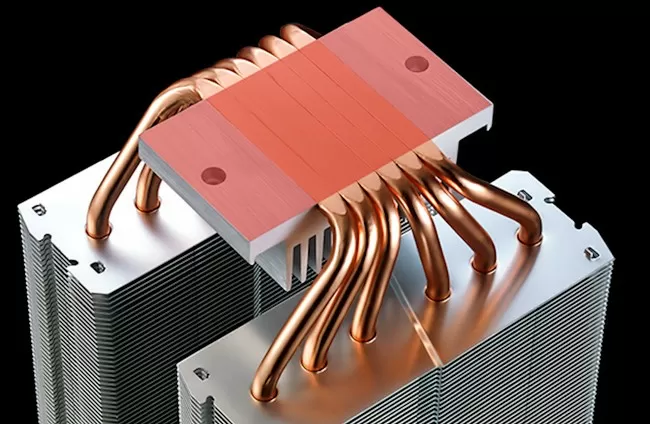
Cooler Master error in MA621P TR4 Edition cooler
In most liquid cooling systems, as a rule, the sole has a round shape, and against the background of the processor, the construction looks absolutely ridiculous, although compatibility with TR4/SP3 is stated in the product specifications.
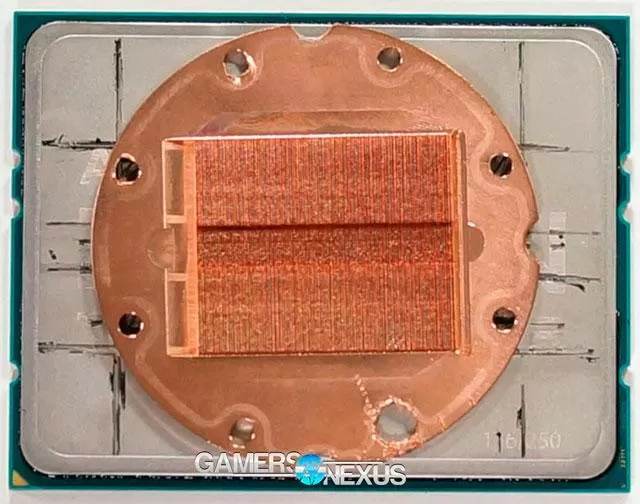
Typical arrangement of the SVO heat sink (Photo by GamersNexus)
The contact area between the processor and the cooler has increased 4-5 times over the past decade, the dimensions of the radiators have practically not changed, and in order to maintain a low noise level, you need to take into account the location of each heat-conducting tube, because noise (in addition to reliability) is the most important criterion for buying a cooler class Hi-End.
Today we will look at a whole series of Noctua coolers designed for the AMD TR4/SP3 platform, that is, for server EPYCs or desktop ThreadRippers.
- NH-U14S TR4-SP3 - designed specifically for graphic and multimedia workstations, because it is quiet
- NH-U12 TR4-SP3 is a normal 'workhorse for a standard 120mm fan
- NH-U9 TR4-SP3 - for server chassis from 4U
|
Characteristics |
NH-U14S TR4-SP3 |
NH-U12 TR4-SP3 |
NH-U9 TR4-SP3 |
|
Cooler dimensions, mm |
165x150x78 |
158x125x71 |
125x95x120 |
|
Radiator dimensions, mm |
165x150x52 |
158x125x45 |
125x95x71 |
|
Number of heat transfer pipes |
6 |
5
|
6 |
|
Material |
Copper: base, heat pipes
| ||
|
Fan dimensions, mm |
140x150x25 |
120x120x25 |
2 x 92x92x25 |
|
Fan regulation |
PWM | ||
|
Fan speed, RPM |
300 - 1500 |
300 - 1500 |
400 - 2000 |
|
Max. fan performance, CFM |
82,4 |
54.9 |
46.4 |
|
Rotor suspension |
SSO II | ||
|
Max. noise level, dB |
24.6 |
22,4 |
22.8 |
|
LNA Slow Down Adapter Included |
Yes | ||
|
Weight, g. |
1030 |
870 |
895 |
I would like to draw your attention to the fact that all three coolers are supplied with L.N.A. adapters, - resistors that reduce the voltage on the fans. We traditionally recommend not using them, but adjusting the blade speeds through the motherboard BIOS, especially since all modern motherboards already do this very well.
All three coolers allow you to install 2 fans, and with two of the coolers you get wire mounts for installing an additional one. As for the 92mm model, it comes from the factory with a couple of fans, and we will start with this cooler.
In general, NH-U9 TR4-SP3 is a cooler that can be considered as a replacement for Supermicro or Dynatron. A two-fan solution is always a higher reliability, because even if one of the fans stands up, the computer will most likely not freeze, and when the load decreases, it will work up to repair. The photo shows very clearly that the heat-conducting pipes are soldered to the plates, so that even from shaking or from time to time, the radiator will not come apart and will not lose its effectiveness. In many ways, this model repeats the NH-U9DO A3, released for Socket G34, only with an increased TDP: today tests show that this baby is capable of cooling a 180 W Threadripper. It remains a mystery to me why in a 2-fan cooler with a `` pull-push '' scheme the manufacturer did not close the side walls of the radiator to increase the pressure between the plates, as is done, for example, in the new NH-U12A.
Keep in mind that this cooler is the only one of the three with fans hanging over the memory slots, and it is for this reason that the developer could not make it lower to fit in 3U. So, during installation, you have to remove both fans, screw the mount, and only then put them back. In practice, here your fan almost touches a regular memory module, and in servers this problem may not appear, and in workstations with ThreadRipper processors and gaming memory with high heatsinks, your cooler will not fit on the board. This cooler does not conflict with other components of the motherboard or with the video card. And yet, I repeat: NH-U9 TR4-SP3 is a more professional solution for machines running 24x7.
Noctua NH-U12 TR4-SP3 is a workhorse this series. This cooler has a symmetrical heatsink for 120mm fans and comes with one NF-F12PWM by default with a high pressure optimized impeller. In general, the radiator is narrow here - only 45 mm, and this fan design looks superfluous. If you're interested - you can see our review Noctua NF-F12 IndustrialPPC-3000 PWM , where we detail talk about the features of this impeller and inflate the test bag at 3000 RPM. In this model, the fan also hangs over the memory modules, but the clearance is sufficient so as not to rest against even gaming DIMMs with heatsinks. In our photos, the fan is pushed down as much as possible, and memory modules do not interfere with it, but you can put it higher. In any case, it is the last thing to install on the heatsink when the processor, memory and heatsink are already installed on the motherboard.
Keep in mind that NH-U12 TR4-SP3 is the quietest of the three, and at any speed the heatsink is perfectly blown by even one fan, so there is no point in installing a second one to increase performance, but for a backup solution - yes, please.
The NH-U14S TR4-SP3 model promises the maximum performance with a 140mm NF-A15 PWM fan of an unusual design, which is more wide than long. I would like to warn musicians and owners of sensitive hearing right away: at minimum speeds of about 300 RPM, you can hear the driver clicking on these fans. That is, you will not get absolutely all-consuming silence from this cooler with a standard fan, no matter how hard you try. If this moment is not decisive for you, then solid pluses begin further: a 52 mm thick radiator, which is closed from the sides more than half the thickness to concentrate the air flow. In practice, this means that the installation of a second fan `` blowing out '' can give you a noticeable drop in CPU temperature. Interestingly, even in the lower part of the radiator, where there is a narrowing, the ribs are still bent on the sides to create walls for the air flow: this is a real European approach to business.
In profile, there is a very successful arrangement of heat-conducting tubes, which together form two such rings, or even cylinders, through which heat is distributed over the radiator in the area where the air flow is maximum. The cooler's dimensions allow you not to think about compatibility with memory modules: although the fan hangs over the DIMM slots, when installed, there is a gap under it that you can stick your finger through.
Testing
The following configuration was used for testing:
- ASRock Rack EPYCD8-2T Motherboard
- AMD EPYC 7551 Processor (180W)
- Hypervisor: VMware ESXi 6.7 U1
- Operating system: Windows 10 x64 (32 vCPU)
- Warm-up software: OCCT Linpak

In terms of noise level at maximum speed, the coolers showed the following results:
- NH-U14S TR4-SP3: 23.6 dB
- NH-U12 TR4-SP3: 27.9 dB
- NH-U9 TR3-SP3: 31.7 dB
before is, absolutely not what the manufacturer claims. The noise level of each cooler is shown in more detail on the histogram below:

In general, without a doubt, the NH-U14S TR4-SP3 is much quieter than its colleagues.
Conclusions
For AMD TR4/SP3 platform, select dedicated coolers that provide uniform heat dissipation from the processor. Noctua coolers prove by their own example that high-quality air cooling works better than liquid cooling.
The NH-U14S TR4-SP3 became the clear winner in our test, and if the dimensions and budget of the case allow, we recommend buying this particular model for any, even the most loaded workstation. The other two coolers are just as good as a traditional alternative to CBO for installation in compact cases, but they no longer show such a brave advantage as the NH-U14S TR4-SP3, so if you really want to use liquid cooling in your workstation, you'd better buy GPU with CBO, and on the processor "air" still what the doctor ordered.
Mikhail Degtyarev (aka LIKE OFF)
28/05.2019










